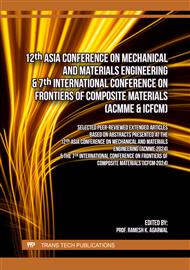[1]
Kiran, K., & Kishore, I. S., "An experimental study on partial replacement of cement with bagasse ash in concrete mix.", International journal of civil engineering and technology, vol. 8, no. 1, pp.452-455, 2017.
Google Scholar
[2]
Jha, P., Sachan, A. K., & Singh, R. P., "Agro-waste sugarcane bagasse ash (ScBA) as partial replacement of binder material in concrete" Materials Today: Proceedings, vol. 44, pp.419-427, 2021.
DOI: 10.1016/j.matpr.2020.09.751
Google Scholar
[3]
Andreão, P. V., Suleiman, A. R., Cordeiro, G. C., & Nehdi, M. L., "Beneficiation of sugarcane bagasse ash: Pozzolanic activity and leaching behavior.", Waste and Biomass valorization, vol. 11, pp.4393-4402, 2020.
DOI: 10.1007/s12649-019-00721-x
Google Scholar
[4]
Jangkorn, S., Youngme, S., & Praipipat, P., "Comparative lead adsorptions in synthetic wastewater by synthesized zeolite A of recycled industrial wastes from sugar factory and power plant," Heliyon, vol. 8, no. 4, e09323, 2022.
DOI: 10.1016/j.heliyon.2022.e09323
Google Scholar
[5]
Chuenpratoom, T., Hemavibool, K., Rermthong, K., & Nanan, S., "Removal of lead by merlinoite prepared from sugarcane bagasse ash and kaolin: synthesis, isotherm, kinetic, and thermodynamic studies.", Molecules, vol. 26, no. 24, 7550, 2021.
DOI: 10.3390/molecules26247550
Google Scholar
[6]
Zaheer, M. M., & Tabish, M., "The Durability of Concrete Made Up of Sugar Cane Bagasse Ash (SCBA) as a Partial Replacement of Cement: A Review," Arabian Journal for Science and Engineering, vol. 48, no. 4, pp.4195-4225, 2023.
DOI: 10.1007/s13369-023-07698-9
Google Scholar
[7]
Jagadesh, P., et al., "Effect of processed sugarcane bagasse ash on compressive strength of blended mortar and assessments using statistical modelling.", Case Studies in Construction Materials, vol. 19, e02435, 2023.
DOI: 10.1016/j.cscm.2023.e02435
Google Scholar
[8]
de AM Rezende, M., Corradini, P. G., Sales, A., & Mascaro, L. H., "Electrochemical study on the chloride corrosion susceptibility of cementitious composites produced with sugarcane bagasse ash sand" Construction and Building Materials, vol. 397, 132341, 2023.
DOI: 10.1016/j.conbuildmat.2023.132341
Google Scholar
[9]
Athira, G., Bahurudeen, A., & Vishnu, V. S., "Availability and accessibility of sugarcane bagasse ash for its utilization in Indian cement plants: A GIS-based network analysis.", Sugar Tech, vol. 22, pp.1038-1056, 2020.
DOI: 10.1007/s12355-020-00842-x
Google Scholar
[10]
Concrete, A.C.C.-o. and C. Aggregates, Standard specification for coal fly ash and raw or calcined natural pozzolan for use in concrete. (ASTM international 2013).
DOI: 10.1520/c0618-17
Google Scholar
[11]
Jittin, V., Minnu, S. N., & Bahurudeen, A., "Potential of sugarcane bagasse ash as supplementary cementitious material and comparison with currently used rice husk ash.", Construction and Building Materials, vol. 273, 121679, 2021.
DOI: 10.1016/j.conbuildmat.2020.121679
Google Scholar
[12]
Mangi, S. A., Memon, Z. A., Khahro, S. H., Memon, R. A., & Memon, A. H., "Potentiality of industrial waste as supplementary cementitious material in concrete production.", International Review of Civil Engineering (IRECE), vol. 11, no. 5, pp.214-221, 2020.
DOI: 10.15866/irece.v11i5.18779
Google Scholar
[13]
Garcia-Perez, T., Ortiz-Ulloa, J. A., Jara-Cobos, L. E., & Pelaez-Samaniego, M. R., "Adding Value to Sugarcane Bagasse Ash: Potential Integration of Biogas Scrubbing with Vinasse Anaerobic Digestion.", Sustainability, vol. 15, no. 21, 15218, 2023.
DOI: 10.3390/su152115218
Google Scholar
[14]
Reginato, L. A., Lorenzi, A., de Oliveira, L. C., Lorenzi, L. S., & da Silva Filho, L. C. P., Corrosion in reinforced concrete: Diagnostics through Potential Corrosion Technique., 2023.
DOI: 10.21203/rs.3.rs-3156721/v3
Google Scholar
[15]
Jagadesh, P., Ramachandramurthy, A., & Murugesan, R., "Processing of sugar cane bagasse ash and properties of processed sugar cane bagasse ash blended cements.", Sādhanā, vol. 47, no. 4, p.187, 2022.
DOI: 10.1007/s12046-022-01963-7
Google Scholar
[16]
Jha, P., Sachan, A. K., & Singh, R. P., "Agro-waste sugarcane bagasse ash (ScBA) as partial replacement of binder material in concrete.", Materials Today: Proceedings, vol. 44, pp.419-427, 2021.
DOI: 10.1016/j.matpr.2020.09.751
Google Scholar
[17]
Wei, N., "Leachability of heavy metals from lightweight aggregates made with sewage sludge and municipal solid waste incineration fly ash.", International Journal of Environmental Research and Public Health, vol. 12, no. 5, pp.4992-5005, 2015.
DOI: 10.3390/ijerph120504992
Google Scholar
[18]
Akyıldız, A., Köse, E. T., & Yıldız, A., "Compressive strength and heavy metal leaching of concrete containing medical waste incineration ash.", Construction and Building Materials, vol. 138, pp.326-332, 2017.
DOI: 10.1016/j.conbuildmat.2017.02.017
Google Scholar
[19]
Tajudin, S. A. A., et al., "Utilization of sugarcane BagAsse ash for stabilization/solidification of lead-contaminated soils.", Jurnal Teknologi, vol. 77, no. 11, pp.119-125, 2015.
DOI: 10.11113/jt.v77.6430
Google Scholar



